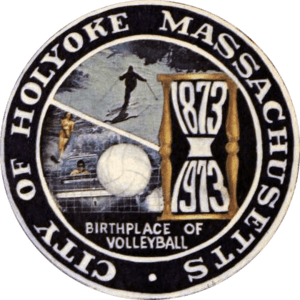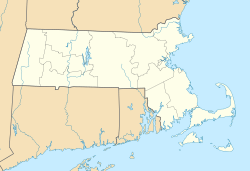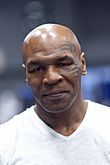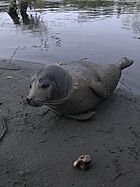Holyoke, Massachusetts facts for kids
Quick facts for kids
Holyoke, Massachusetts
|
|||||
|---|---|---|---|---|---|
|
Clockwise from top: The Holyoke skyline with the clock tower of City Hall and Mount Tom Range in the background, Holyoke Heritage State Park and the Canalwalk, the Holyoke Dam, the Beech Street landscape in spring, and North High Street Historic District
|
|||||
|
|||||
| Nickname(s):
The Paper City
Birthplace of Volleyball The Venice of America |
|||||
| Motto(s):
Industria et Copia (Latin)
"Industry and Abundance" |
|||||

Location in Hampden County in Massachusetts
|
|||||
| Country | |||||
| State | |||||
| County | Hampden | ||||
| Settled | 1655 | ||||
| Incorporated (parish) | July 7, 1786 | ||||
| Incorporated (town) | March 14, 1850 | ||||
| Incorporated (city) | April 7, 1873 | ||||
| Founded by | George C. Ewing Boston Associates |
||||
| Named for | Elizur Holyoke | ||||
| Government | |||||
| • Type | Mayor-council city | ||||
| Area | |||||
| • Total | 22.80 sq mi (59.05 km2) | ||||
| • Land | 21.17 sq mi (54.83 km2) | ||||
| • Water | 1.63 sq mi (4.23 km2) | ||||
| Elevation | 200 ft (60 m) | ||||
| Highest elevation | 1,202 ft (366 m) | ||||
| Population
(2020)
|
|||||
| • Total | 38,328 | ||||
| • Density | 1,806.32/sq mi (697.43/km2) | ||||
| Demonym(s) | Holyoker Holyokian (rare) |
||||
| Time zone | UTC−5 (Eastern) | ||||
| • Summer (DST) | UTC−4 (Eastern) | ||||
| ZIP Codes |
01040, 01041 (P.O.)
|
||||
| Area code(s) | 413 | ||||
| FIPS code | 25-30840 | ||||
| GNIS feature ID | 0617679 | ||||
Holyoke is a city in Hampden County, Massachusetts, United States. It sits between the Connecticut River and the Mount Tom Range. In 2020, about 38,247 people lived there. Holyoke is located 8 miles (13 km) north of Springfield. It is part of the larger Springfield area.
Holyoke is one of America's first planned industrial cities. It was built with the Holyoke Dam to use water power from Hadley Falls. The city is known for its grid-like street design. In the late 1800s, Holyoke made about 80% of the writing paper used in the U.S. It was called "The Paper City." Today, fewer paper businesses remain, but the nickname stuck.
The city is also home to the Massachusetts Green High Performance Computing Center. This is a research center that opened in 2012. Holyoke is famous as the "Birthplace of Volleyball." The sport was invented here in 1895 by William G. Morgan at the local YMCA. The Volleyball Hall of Fame is also in Holyoke.
An engineer named Clemens Herschel invented the Venturi meter in Holyoke in the 1880s. This device helped measure water use in the city's canals. It was the first accurate way to measure large water flows. Today, Holyoke has low electricity costs because of its city-owned canals. Most of the city's energy comes from clean sources.
Contents
History of Holyoke
The first people in the Holyoke area were the Algonquian peoples. English colonists arrived in the Connecticut River Valley in 1633. In 1636, William Pynchon led settlers to establish Springfield. This settlement was built north of the river's first major falls. Springfield quickly grew as a trading center.
The land that is now Holyoke was settled by 1655. It was first called "Ireland Parish" in 1786. The area was later named after Elizur Holyoke, who explored it in the 1650s. The town of Holyoke officially became a town on March 14, 1850.

Holyoke did not have many people until the Holyoke Dam was built in 1849. This led to the creation of the Holyoke Canal System. Many water-powered mills, especially paper mills, were then built. At one time, over 25 paper mills operated in the city. The city's population grew from under 5,000 in 1860 to over 60,000 in 1920. Because of this fast growth, Holyoke became a city on April 7, 1873.
By 1885, Holyoke was the biggest paper producer in the United States. It made about 190 tons of paper each day. This was more than double the next largest producer. Holyoke's paper industry led to the creation of the American Pad & Paper Company (AMPAD) in 1888. This company became one of the world's largest office product suppliers.
The city's water power also allowed it to have its own electric company. This meant Holyoke was not affected by major power outages. Many inventions also came from Holyoke. The Holyoke Testing Flume helped improve water turbines. The Venturi meter was invented here. The world's first commercial telephone toll line opened in Holyoke in 1878. The Telharmonium, the world's first electric musical instrument, was also shown here in 1906.
Geography of Holyoke

Holyoke is located at 42°12′11″N 72°37′26″W. The city covers about 22.8 square miles (59.0 km2). Most of this is land, with some water. Holyoke is next to Southampton and Westfield to the west. Easthampton is to the north. The Connecticut River forms its eastern border with Hadley, South Hadley, and Chicopee. West Springfield is to the south.
Holyoke is home to East Mountain and the Mount Tom Range. Mount Tom is the highest peak in this area. It is 1,202 feet (366 m) tall. The Metacomet-Monadnock Trail runs through these mountains. You can find dinosaur tracks and fossils at the base of these mountains. A dinosaur species, Podokesaurus holyokensis, was named after this area.
Neighborhoods of Holyoke
Holyoke has 15 different neighborhoods. Some, like Springdale, were planned for mill workers. Others, like Elmwood, were older villages. Here are some of Holyoke's neighborhoods:
- Churchill – home to Wistariahurst Museum.
- Downtown – features City Hall and the Volleyball Hall of Fame.
- Elmwood – the city's oldest neighborhood.
- The Flats – has the Holyoke Canal System.
- Ingleside – features the Holyoke Mall.
- Smith's Ferry – has the Dinosaur Footprints Reservation.
- South Holyoke – features the Puerto Rican-Afro Caribbean Cultural Center.
- Springdale – Holyoke's largest park.
Architecture and City Planning
Holyoke's rapid growth in the late 1800s led to a huge need for housing. The city's architecture shows a mix of styles. These include Italianate, Gothic Revival, Queen Anne, and Second Empire. Many buildings were designed by local architects like George P. B. Alderman and Oscar Beauchemin.
The city's unique layout comes from being a planned industrial community. Downtown Holyoke has a grid system for its streets. This was unusual for New England at the time. Streets running north to south are named after trees (like Sycamore, Oak, Elm). Streets running east to west are named after the city's founders or Massachusetts counties.

Holyoke's location on the Connecticut River was perfect for using water power. This attracted the Boston Associates, who had developed Lowell, Massachusetts. From the late 1800s to the mid-1900s, Holyoke was the world's largest paper manufacturer. The Holyoke Canal System was built to power the mills. This system makes Holyoke different from other cities along the Connecticut River.
People of Holyoke
| Historical population | ||
|---|---|---|
| Year | Pop. | ±% |
| 1850 | 3,245 | — |
| 1860 | 4,997 | +54.0% |
| 1870 | 10,733 | +114.8% |
| 1880 | 21,915 | +104.2% |
| 1890 | 35,637 | +62.6% |
| 1900 | 45,712 | +28.3% |
| 1910 | 57,730 | +26.3% |
| 1920 | 60,203 | +4.3% |
| 2020 | 38,247 | −36.5% |
| Source:
|
||
In 2020, Holyoke had 38,247 people living in 15,062 homes. The city has a diverse population. Many people have roots from various countries.
Immigration and Cultures
Holyoke has always been a city of immigrants. In 1890, nearly half of Holyoke's residents were born in another country. This was one of the highest rates in the U.S. Early mill workers were mostly Irish. They settled in the area before the dam was built. This is why the area was first called "Ireland Parish." Holyoke celebrates its Irish roots with an annual St. Patrick's Day Parade.
Later, many French-Canadians came to work in the mills. By 1900, one in three residents had French or French-Canadian heritage.
After World War II, many Puerto Ricans moved to Holyoke. They came seeking better job opportunities in the mills. Today, Latinos are the city's largest group. Holyoke has the largest Puerto Rican population per person of any U.S. city outside Puerto Rico. The Puerto Rican community holds an annual Puerto Rican Day parade.
Religion in Holyoke
Holyoke has many churches and synagogues. The First Baptist Church was one of the first congregations, started in 1792. Many residents are Roman Catholic. There are several Catholic parishes and convents in the city.
Protestant churches have also been important in Holyoke's history. There is also a Greek Orthodox church. Holyoke has a notable Jewish population with two synagogues.
Economy of Holyoke
Holyoke's economy was built around the paper industry. It was once the world's largest producer of writing paper. While less paper is made now, Holyoke still has specialty paper manufacturers. Some international companies also have factories here.
The city also has a foreign-trade zone. This helps businesses with international trade. Holyoke has companies that make industrial machinery, medical devices, and plastics. Some food manufacturing firms have also opened here.

Technology and Services
Holyoke has worked to attract high-tech jobs. The Massachusetts Green High Performance Computing Center opened in 2012. This center uses Holyoke's hydropower and fiber network. Popular Mechanics magazine ranked Holyoke as a top city for startups. ISO New England, which manages electricity for the region, is also based here.
The Holyoke Mall at Ingleside is a major employer. It is the third largest shopping mall in New England. The city also has the headquarters of PeoplesBank, a large bank in Western Massachusetts.
Urban Agriculture
Even with its industrial past, farming is still important in Holyoke. The city opened one of the first modern farmers markets in Western Massachusetts in 1917. Today, the market is held outside City Hall.
Nuestras Raices is a notable organization. It helps new farmers, especially in the Puerto Rican community. Holyoke also has an "Edible Food Forest Garden." This garden grows over 100 types of perennial plants. It has been featured in The New York Times.
Education in Holyoke
Holyoke's schools include Holyoke Public Schools and Holyoke High School. The school system is currently managed by the state. Private schools include First Lutheran School and Mater Dolorosa Catholic School.
The city is home to Holyoke Community College. It was the first community college in Massachusetts. High school seniors can take college courses there. The college also opened a Culinary Arts Institute. Bard College has a special program in Holyoke. It helps young mothers earn college degrees.
Holyoke Public Library
The Holyoke Public Library is located at 335 Maple Street. It is a beautiful example of neoclassical architecture. The library opened in 1902. It was built with money raised by citizens. William Whiting, the library president, called it the "people's college." He said it offers knowledge to make life useful and happy.
Culture in Holyoke
Many artists have ties to Holyoke. Sculptor Jerome Connor lived here. He is known for his sculptures in Washington, D.C. Good Housekeeping magazine was first launched in Holyoke in 1885. Novelist John Clellon Holmes, who wrote about the Beat Generation, was from Holyoke. Photographers like Ray D'Addario and William Wegman also came from the city.
Holyoke was a popular stop for Vaudeville shows. Famous actress Eva Tanguay started her career here. She became one of America's first mass-media celebrities. Other stars like Bing Crosby and The Marx Brothers performed at the Victory Theater. The Valley Arena Gardens hosted many famous musicians. These included Count Basie and Duke Ellington.
Today, efforts are being made to restore the Victory Theater. Holyoke also has the Gateway City Arts venue for music. The Holyoke Civic Symphony has been playing since 1967.
Museums in Holyoke

Besides the Volleyball Hall of Fame, Holyoke has Wistariahurst. This was the home of the Skinner Family, who made silk. The museum has art exhibits and historical collections.
The Children's Museum at Holyoke opened in 1984. It has many hands-on exhibits for kids. These include a water table and a Lite-Brite wall.
Annual Events in Holyoke
Holyoke hosts the second-largest St. Patrick's Day parade in the U.S. It happens every year in March. Hundreds of thousands of people come to watch. The Holyoke Caledonian Pipe Band, founded in 1910, has been in every parade.
Since 1962, the city has held an annual Shad Derby in May. This fishing contest celebrates the American shad population in the Connecticut River.
In June, Holyoke holds a rainbow flag-raising ceremony for Gay Pride Month. The Puerto Rican community has its own annual parade in July. "Celebrate Holyoke" is held in August at Holyoke Heritage State Park. It features music, food, and local businesses. In September, South Holyoke hosts El Sabor de South Holyoke. This festival celebrates local Puerto Rican cuisine.
The International Volleyball Hall of Fame holds its induction ceremony every November. It honors the best players and contributors to the sport.
Points of Interest in Holyoke
- Dinosaur Footprints Reservation: See preserved dinosaur footprints.
- Holyoke Canal System: Explore the historic canals.
- Holyoke Heritage State Park: A park with museums and events.
- Holyoke Mall at Ingleside: A large shopping mall.
- Holyoke Merry-Go-Round: A classic carousel.
- Mount Tom: A mountain with hiking trails and great views.
- Robert E. Barrett Fishway: A system that helps fish swim past the dam.
- Victory Theater: A historic theater being restored.
- Wistariahurst Museum: A beautiful historic estate.
Sports in Holyoke

Birthplace of Volleyball
On February 9, 1895, William G. Morgan invented volleyball in Holyoke. He first called it "mintonette." The Volleyball Hall of Fame is now located at Holyoke Heritage State Park. It honors athletes and coaches from the sport.
Baseball in Holyoke
The Valley Blue Sox baseball team plays at Mackenzie Stadium. They are part of the New England Collegiate Baseball League. Holyoke has also been home to other minor league and college baseball teams in the past.
Boxing in Holyoke
Holyoke has a strong boxing history. Sixto Escobar, the first Puerto Rican world champion, had his first U.S. fight here. Rocky Marciano made his professional debut at the Valley Arena Gardens in 1947. Even Mike Tyson fought here early in his career. The Golden Gloves boxing tournament was held in Holyoke for many years.
Golf in Holyoke

Holyoke has two private golf courses: Holyoke Country Club and Wyckoff Country Club. The Wyckoff Country Club was designed by famous golf architect Donald Ross. He lived in Holyoke for some time.
Parks and Recreation
Holyoke has many parks, including some designed by the Olmsted Brothers. Springdale Park is the largest. It hosts the annual Western Massachusetts Puerto Rican Parade. The city has 47 parks and recreation areas. These include baseball fields, playgrounds, and a skatepark.
The Holyoke Water Works protects land around its reservoirs. Some of these areas, like Ashley Reservoir, are open for hiking. The New England National Scenic Trail also passes through this area.

Two state parks are in Holyoke: Mount Tom State Reservation and Holyoke Heritage State Park. The Trustees of Reservations also manage parks like the Dinosaur Footprints Reservation.
Environment and Wildlife
Holyoke has worked to improve its environment. A former coal plant was closed in 2014. A new solar farm is being built on its site.
Much of Holyoke's western area is protected for wildlife. This area is home to many animals. These include 29 types of fish, 21 amphibians, and 18 reptiles. Over 160 bird species, like bald eagles, live here. There are also 42 mammal species, such as black bears and moose.
Global Connections
Holyoke has sister city relationships with:
 Svaliava, Ukraine (1997)
Svaliava, Ukraine (1997) Tralee, Ireland (2017)
Tralee, Ireland (2017)
The city has also had other special connections:
 Montreal, Canada (1888): A large group from Montreal visited Holyoke.
Montreal, Canada (1888): A large group from Montreal visited Holyoke. Beijing, China (1906): A Chinese scholar studied Holyoke's paper industry.
Beijing, China (1906): A Chinese scholar studied Holyoke's paper industry. Dublin, Ireland (1906): Irish leaders visited to promote independence.
Dublin, Ireland (1906): Irish leaders visited to promote independence. Apremont-la-Forêt, France (1919): Holyoke helped rebuild this French village after World War I.
Apremont-la-Forêt, France (1919): Holyoke helped rebuild this French village after World War I. San Juan, Puerto Rico (2018): Holyoke welcomed many Puerto Ricans after Hurricane Maria.
San Juan, Puerto Rico (2018): Holyoke welcomed many Puerto Ricans after Hurricane Maria.
Notable People
See also
 In Spanish: Holyoke (Massachusetts) para niños
In Spanish: Holyoke (Massachusetts) para niños




































